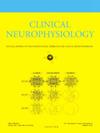Reduction of sleep-like perilesional slow waves and clinical evolution after stroke: A TMS-EEG study
IF 3.7
3区 医学
Q1 CLINICAL NEUROLOGY
引用次数: 0
Abstract
Objective
Recent studies indicate that brain injuries often lead to the occurrence of sleep-like slow waves in perilesional cortical areas. These slow waves may disrupt local cortico-cortical interactions and contribute to behavioral impairments but are, in principle, reversible. This study employs Transcranial Magnetic Stimulation (TMS) combined with Electroencephalography (EEG) to monitor changes in perilesional slow waves and local cortical interactions examining their relation to changes in stroke severity.
Methods
Twelve patients with post-acute/chronic unilateral ischemic cortical stroke participated in a longitudinal study with two assessment points. Each assessment included a neurological evaluation using the National Institutes of Health Stroke Scale (NIHSS) and TMS-EEG recordings targeting perilesional cortical areas. Neurophysiological parameters, such as slow wave amplitude (SWa), high-frequency power (HFp) suppression, and the Perturbational Complexity Index-state transition (PCIst), were extracted from the perilesional EEG responses to TMS to quantify local sleep-like slow waves and cortical interactions.
Results
We observed a perilesional reduction in sleep-like slow waves and a restoration of local cortical interactions. Notably, these changes significantly correlated with patients’ clinical evolution as assessed by the NIHSS score.
Conclusions
These findings highlight the potential of TMS-EEG as an objective tool for tracking neurological evolution post-stroke.
Significance
Targeting sleep-like cortical dynamics may be relevant for devising post-stroke rehabilitation strategies.
脑卒中后睡眠样病变周围慢波减少和临床演变:一项TMS-EEG研究
目的近年来的研究表明,脑损伤可导致皮层周围区域出现睡眠样慢波。这些慢波可能会破坏局部皮质-皮质相互作用,导致行为障碍,但原则上是可逆的。本研究采用经颅磁刺激(TMS)联合脑电图(EEG)监测病灶周围慢波和局部皮层相互作用的变化,研究它们与中风严重程度变化的关系。方法对12例急性/慢性单侧缺血性皮质性脑卒中患者进行纵向研究,采用两个评估点。每次评估包括使用美国国立卫生研究院卒中量表(NIHSS)和针对病灶周围皮层区域的TMS-EEG记录进行神经学评估。神经生理学参数,如慢波振幅(SWa)、高频功率(HFp)抑制和摄动复杂性指数状态转换(PCIst),从颅磁刺激的病灶周围脑电图反应中提取,以量化局部睡眠样慢波和皮层相互作用。结果我们观察到病灶周围睡眠样慢波的减少和局部皮层相互作用的恢复。值得注意的是,这些变化与NIHSS评分评估的患者临床进展显著相关。结论TMS-EEG作为一种追踪脑卒中后神经系统进化的客观工具,具有重要的应用价值。针对睡眠样皮质动力学可能与设计卒中后康复策略相关。
本文章由计算机程序翻译,如有差异,请以英文原文为准。
求助全文
约1分钟内获得全文
求助全文
来源期刊

Clinical Neurophysiology
医学-临床神经学
CiteScore
8.70
自引率
6.40%
发文量
932
审稿时长
59 days
期刊介绍:
As of January 1999, The journal Electroencephalography and Clinical Neurophysiology, and its two sections Electromyography and Motor Control and Evoked Potentials have amalgamated to become this journal - Clinical Neurophysiology.
Clinical Neurophysiology is the official journal of the International Federation of Clinical Neurophysiology, the Brazilian Society of Clinical Neurophysiology, the Czech Society of Clinical Neurophysiology, the Italian Clinical Neurophysiology Society and the International Society of Intraoperative Neurophysiology.The journal is dedicated to fostering research and disseminating information on all aspects of both normal and abnormal functioning of the nervous system. The key aim of the publication is to disseminate scholarly reports on the pathophysiology underlying diseases of the central and peripheral nervous system of human patients. Clinical trials that use neurophysiological measures to document change are encouraged, as are manuscripts reporting data on integrated neuroimaging of central nervous function including, but not limited to, functional MRI, MEG, EEG, PET and other neuroimaging modalities.
 求助内容:
求助内容: 应助结果提醒方式:
应助结果提醒方式:


